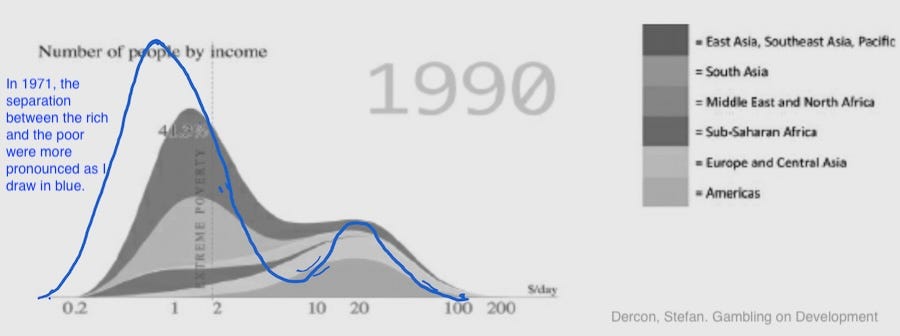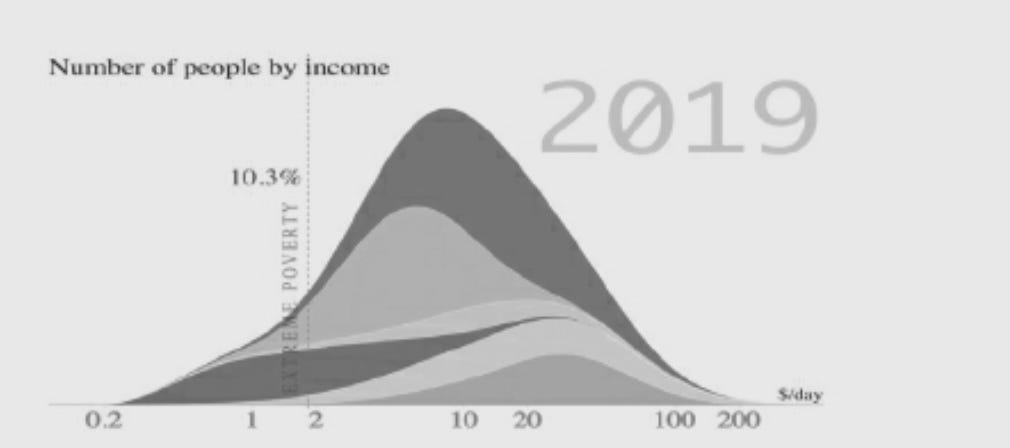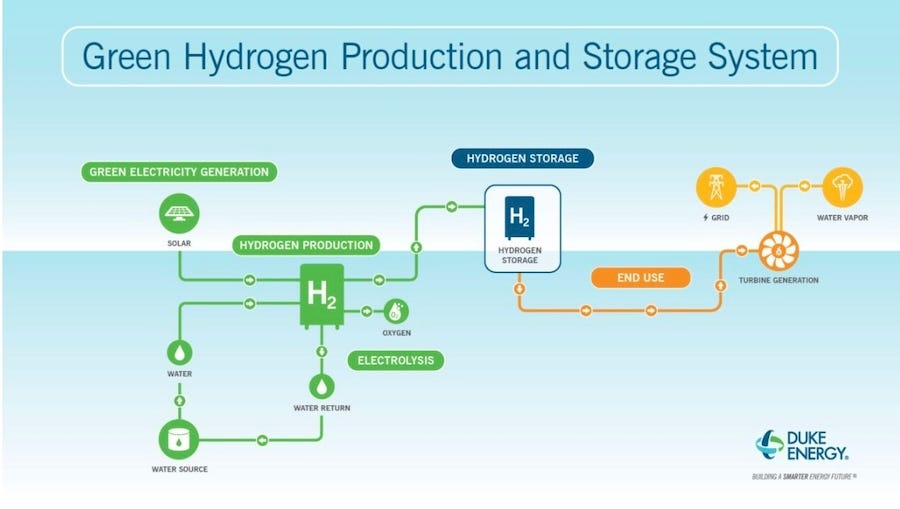The importance of elite consensus
Elite consensus is of critical importance for national development says Dercon. I think the same goes for nations to stay developed especially in the ROGUE Age
Please subscribe; please share. This blog will always be free but worthy reading.
-+-+-+-+
When I started university in 1971, the world was clearly divided into two camps: rich nations and poor nations. It didn't look like it was possible within our lifetimes that two would ever meet. Not so. The gap between the two peaks had started to shrink even at that time and by 1990 they already had converged like two hills on the same mountain as the following figure shows. The background chart is from a book I have been reading over the last couple of weeks: Dercon, Stefan. Gambling on Development. The book says that the valley between the two peaks were a lot shallower in 1970s. Based on this assertion, I added the blue curve that shows what the global income distribution probably looked like in 1970s.

Fast forward to present time. The income distribution is not bi-modal any more and the rich, the poor and the wretched of the earth are all mixed together in one lognormal distribution:

-*-*-
In 1970s, I did not expect this. No one did. In fact, the World Bank economist the Turkish coup leaders recruited in 1971, Atila Karaosmanoglu, had predicted that it would be at least 2359 before a country like Turkey could catch up with a country like Italy.
We were wrong. As the 2019 chart shows, the poor and rich nations of the world are of one sample population today. This probably means two things happened between 1970s and 2019:
The gap between the rich and the poor in rich countries became wider
The gap between the rich and the poor countries became narrower.
Not all poor countries developed uniformly. Some countries developed very fast, some stayed where they were, and some even went backwards. In 2008, an eminent group of economists studied many nations to try to understand how development was easier for some and not for others. They found there was no single recipe. Different countries followed different routes (Spence, 2008).
This does not stop theoreticians continuing to conjure up development recipes.
-+-+-+-+
Jeffrey Sachs published The End of Poverty in 2005 and similar afterwards. According to him, countries that failed to develop did so either because they were cursed by a local geographical or climate challenge; or because they lacked money. His solution was foreign aid to provide the 'first push'.
Banerjee and Duflo, in Poor Economics, basically said the same thing but they offered a multi-step intervention program to accompany foreign aid. Otherwise, they said the money would be wasted.
William Easterly’s The White Man’s Burden, first published in 2006, basically said that corrupt governments and failing institutions were the reason why the poor nations were poor and foreign aid would do nothing to remedy this situation and even would make things the worse.
Zambian Dambisa Moyo, a former Goldman Sachs advisor, went further in her book Dead Aid: Why Aid Is Not Working and How There Is a Better Way for Africa. Large-scale aid was crippling African economies and led to governments begging for more, she observed in 2010. She favoured free market solutions.
Joseph Stiglitz, in Globalization and Its Discontents, argued it was not the aid but the global governance of aid that was the problem and we had to reform the global aid and credit system. Dani Rodrik, in The Globalization Paradox: Democracy and the Future of the World Economy (2011) and subsequent work, expressed similar views.
Daron Acemoglu and James Robinson, in Why Nations Fail, identified the lack of 'institutions' as the main cause for failure. These institutions were shaped by history, and in turn they determined today’s economic, social, and political behaviour. In the final analysis, Acemoglu and Robinson were not that different from Easterly in laying the blame on the poor: their national history was the reason for failing to develop.
-+-+-+-+
Development is a Gamble for the Elites
The above brief summary of development literature is from Dercon’s book. Stefan Dercon argues that while all of these theories have valid points they do not explain how some nations are able to develop and some are not. Dercon gives a much more volitional explanation:
Successful growth and development requires the presence of a development bargain—that is, an underlying commitment to growth and development by members of a country’s elite (the people within the fabric of society, the economy, and politics who make decisions (Dercon, p 20)
Three conditions need to be satisfied:
Durable political and economic deals among the elite
A mature sensible state
Ability to learn from mistakes and correct courses
This commitment to growth is a gamble for the elites because development is change and change always endangers entrenched privilege.
I think I like Dercon's thesis. It gives agency to honest politicians in poor nations. It tells them that the key to development is achieving a consensus and a commitment to development amongst the country's elites. It also tells them that without such consensus all efforts would fail.
I have a corollary for Dercon's thesis. I think elite consensus is essential not only for development but also for maintaining this developed status. If such consensus is broken, we see even a highly-developed nation starting to struggle as we have seen in United Kingdom and are possibly starting to see in United States.
Dercon's book gives a lot of anecdotal evidence supporting the development gamble hypothesis. It is difficult to rigorously prove or disprove any hypothesis in this dismal science called economics and anecdotal evidence is as good as any other evidence..
References
Acemoglu, D., and J. Robinson. 2012. Why Nations Fail. London: Profile Books.
Banerjee, A., and E. Duflo. 2011. Poor Economics. New York: Public Affairs.
Dercon, Stefan. Gambling on Development. Hurst Publishers. Kindle Edition.
Easterly, W. 2006. The White Man’s Burden: Why the West’s Efforts to Aid the Rest Have Done So Much Ill and So Little Good. Oxford: Oxford University Press.
Moyo, D. 2009. Dead Aid: Why Aid Is Not Working and How There Is a Better Way for Africa. London: Allen Lane.
Sachs, J. 2005. The End of Poverty: How We Can Make It Happen in Our Lifetime. New York: Penguin Press.
Spence, M. 2008. World Bank Growth Report
Sitglitz, J.E. 2002. Globalization and Its Discontents. New York: Norton and Norton.
-+-+-+-+
Short Takes
Florida’s Duke Energy to use peaking turbines running on solar-produced hydrogen
Power Magazine, 16 November 2023, Sonal Patel
Storing excess electricity as hydrogen and, using a hydrogen-burning turbine, converting it back to electricity when needed is simple in concept. There are technical difficulties. GE Vernova (used to be just GE General Electric), Duke Energy and the consultant engineering firm Sargent&Lundy are planning to demonstrate world’s first peaking hydrogen turbine in late 2024 at Duke Energy’s DeBary power plant in Florida. This plant at the moment has
74.5 MWe Solar PV
692 MWe gas power (six GE 7B and four GE 7E turbines)
The demo will involve two 1-MW PEM electrolysers procured from Plug Power. These electrolysers can generate 36 kg of H2 per hour at an efficiency of 65%.
FACT CHECK - The efficiency is the ratio of the output to the input. The output is hydrogen heating value (MJ/kg) multiplied with production rate (m, kg/s). The hydrogen produced is to be burned in a gas turbine. Therefore, the Lower Heating Value (LHV) should be used: LHV=120 MJ/kg; m=36/3600 kg/s. The input is the electricity coming from the PV array = 2 MWe. Hence the efficiency is 60%:
So I calculate an efficiency lower than what is reported. I do not know the cause of the difference. I trust my number better.
The article does not provide the expected turbine efficiency. The typical peaking (open-cycle) gas turbine efficiencies are around 35-40%. If we assume that the hydrogen turbine will enjoy similar efficiencies, the round trip efficiency (electricity out divided by electricity in) is 60% x 40% = 24%. This is very low. Even with the high prices obtained when the turbine is providing an ancillary service (helping poweer grid stability by providing power on demand), it is difficult to see this as a winning commercial proposition.
-+-+-+-+
You Tube
This video tells a story about a dictator who runs an anticorruption campaign. The story is intended as an allegory to capture some of the game theory dynamics at play at a population level.
I am a subscriber to this channel, The New Enlightenment with Ashley. It is not a well-subscribed channel (although with 5000 subscribers, it is well above the number of subscribers to this blog). I like the way she organises and presents her topic. I found this video quite interesting. The tricks she mentions are used in many countries both to pacify mass opposition and eliminate political rivals in one go.
-+-+-+-+
Diary
We have a friend mowing our lawn and tidying up the garden as needed. He is a lovely man named John. As a break from gardening, I would make coffee and we would have a chat over coffee and biscuits. Unfortunately, he had a heart attack three weeks ago and had to have an operation. He is recovering now and I am hoping he will get better soon. But even if he gets 100% better, I did not think it would be OK for him to do strenuous work like lawn mowing especially in Brisbane summer heat. I would love to have him back to do gardening when he is better but I think I should take over mowing and trimming part of gardening. So two weeks ago I bought a lawnmower and last week I bought an edge trimmer. They both run on batteries. We used to have a Makita blower running on 5 A-h batteries. I chose Makita for the mower and the trimmer and they all use the same kind of batteries. This makes it easier.
Lawnmowing is relatively straightforward. Trimming the edges with a string trimmer was something I had never done before. After destroying the lawn in a few places, I think I am getting the hang of it now. To do edging (clean the boundaries), you need the string rotating in a vertical plane and watch the distance from the concrete edge. If you get to close to the edge, your string wears off too quickly. If you get away from the concrete, you drive ugly grooves into your lawn. I think I am getting there.
I have no photos of the mower nor the trimmer unfortunately and I will not take them out of the shed just to take a picture. I will post photos in the next Diary entry.
-+-+-+-+
A truck rolled over on Cunningham Highway near Brisbane spilling a whole truck load of frozen chickens onto the road. Boxes with thousands of chickens in them have been scattered along the road.
I wonder if the vehicles stuck in the traffic were compensated by serving themselves.
-+-+-+-+
Pascal Hagi
It was 30 degrees in the shade today. Here are Pascal and Hagi surviving through the day by minimising movement.
I sprayed them using a garden hose. First Pascal,
and then together:
Then wanted to go into the house following me but I did not let them. I was scared the air conditioning inside could make them catch cold.
-+-+-+-+
What I read
I have just finished reading Gareth Powell’s Embers of War
Powell is a British author and I think he grew up reading Iain Banks. His universe is similar to Banks’ Culture. In this book however the humanity is helped by other starfaring people to faster-than-light travel capability. These other races are however seem to be compassionate people. This is not like Brin’s Uplift books, which make an analogy with the imperialist and colonial countries of the history. I am not going to talk about the plot because all SF plots look silly when you try to explain them in a few sentences. If you liked Iain Banks, I think you would like Gareth Powell. This is the first book in a series. I think I am going to read the other ones in the series but first I will read a new book from my favourite Brisbane writer Trent Dalton: Lola in the Mirror.
-+-+-+-+
Zika Statistics
Here you will see how the height and weight of the rye sourdough bread changes from week to week:
The date for Day 0 is 4 October 2023. I explain here how and why I started this plot.









I think we are all of the same population now (in the statistical meaning of the population). I do not think the new technology development is exclusive to rich nations any more. Similarly, there is no justification to blame the rich if a country is not able to lift itself up from poverty. Because many other countries were able to get up.
The rich nations had one way or another imperialistic past performance of exploiting poor nations' or tribes' natural resources or even worse slavery for free labour. However as correctly observed they also developed necessary institutions to foster capital build-up, supported by industrial developments. Nowadays part of the prosperity gains by poorer nations might be due to subcontracting of the industrial and manual production for the developed nations. While the latter are developing new technologies to rule the rest of the world. Please also note that those developed nations have no intention to compensate for their ecological footprint responsibilities of the past.